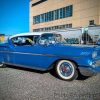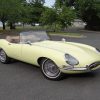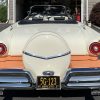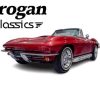1923 ALVIS
Description
This 1923 Alvis 12/40 TC was despatched as an unbodied chassis on December 7, 1923, to Australia, where it is said to have been fitted with four-seater coachwork by Charles Kirkham in Sydney. Car number 7664 was purchased as a project in 1968 by a New South Wales father and son who later moved it inland before selling it as a running chassis to a Vintage Sports Car Club of Australia officer. After returning to the UK in 2000, the car was acquired by a former Alvis employee who commissioned the fabrication of aluminum duck’s-back coachwork. In the late 2000s it was re-imported as an unfinished project to Australia, where it received a refurbishment that included completion of its bodywork and frame as well as rebuilds of its numbers-matching 1,598cc side-valve inline-four, running gear, and other mechanical components. The car was completed in 2013 and subsequently advertised for sale before being acquired in 2014 by a UK owner and arriving back in the UK in 2015. It was then purchased by the seller in 2018. Features include a four-speed manual gearbox, a Solex updraft carburetor, an electric starter, rod-operated rear drum brakes, a green painted frame with color-coordinated fenders, green wire wheels, a black soft top, green leather upholstery, and a dickey seat. This 12/40 is now offered in the Netherlands with a copy of its factory build sheet, correspondence regarding its history, photos from the refurbishment, and Dutch registration using the car’s chassis number, 2361. The 12/40 was introduced in 1922 as an evolution of the 10/30, which had been introduced two years prior as the first production car offered by Alvis. Named for its taxable horsepower and estimated actual output, the model featured a steel ladder frame that was clothed in saloon or touring bodywork provided by a choice of UK coachbuilders when sold domestically. Sporting variants were also available with two-seater duck’s-back bodywork by Coventry coachbuilder Carbodies, a style that was carried over to Alvis’ later overhead-valve models. Most exported examples of the 12/40 such as this were dispatched in chassis form only and bodied by local coachbuilders upon delivery. Chassis number 2361 is said to have originally been bodied as a four-seater by Charles Kirkham in Sydney, although only the aluminum scuttle was left of the bodywork by the 2000s. Construction of two-seat duck’s-back touring coachwork was commenced in the early 2000s by a Welsh coachbuilder before panel work was completed by John Selway in Gainsborough, UK. Also fabricated by Selway were the vented windshield, top frame, black double-duck soft top, and matching tonneau. The frame and fenders were finished in sage green after the car’s arrival in Australia in the late 2000s during refurbishment work carried out by Tony Heard in Adelaide, with the color reportedly matched to paint found on the frame prior to the project. Green-painted wire wheels are wrapped in 4.50/4.75-21 Dunlop tires, as is a matching spare mounted obliquely under the tail. Lighting includes CAV headlamps and a Brolt taillight as well as non-period turn signals and brake lights. The cockpit was upholstered by John Selway in the 2000s and features sage green leather over the bench seat, door panels, kick panels, and dickey seat. Green carpeting with leather piping covers the floors in both compartments. The black four-spoke steering wheel is situated on the right-hand side and carries manette controls on its hub. Smiths instrumentation includes a 60-mph speedometer as well as a clock and an oil pressure gauge, while a Brolt ammeter is housed above toggle switchgear. A modern-style coolant temperature gauge is mounted beneath the dash. The four-digit odometer shows 7k miles, approximately 150 of which were added under current ownership. Approximately 1,300 miles are said to have been added since the completion of the refurbishment in 2013. The 1,598cc inline-four features a cast-iron combined block and cylinder head, separate cast-alloy crankcase and sump units, and cast-alloy pistons. Additional features include a single updraft Solex carburetor, thermosiphon cooling with an alloy water jacket atop the cylinder head, a polished access panel for the valvetrain, a camshaft-driven magneto, a dynamo, and an electric starter. The starter motor was replaced approximately six months ago, at which time a new battery was installed. Modifications include canister oil filtration and electrical fuses. The six-volt electrical system has been retained. Power is delivered to the rear wheels via a four-speed manual transmission. The suspension consists of solid axles, semi-elliptical leaf springs, and Andre Hartford friction shock absorbers, while braking is handled at the rear wheels only by rod-actuated drums. Engine number 2707 is stamped on the crankcase and matches the number written on the Alvis build sheet. Gearbox stamping 1691 is shown in the photo gallery below, as is a stamping of chassis number 2361 on the right-front dumb iron. The Alvis build sheet lists the despatch date and component numbers, and it specifies configuration as a chassis only for export to Australia. Images from the refurbishment that was completed in 2013 are included in the gallery below. Also shown in the gallery below is a hand-written note from John Selway regarding work he performed on the car in the mid-2000s. The car was displayed at the Louwman Museum in The Hague in the Netherlands as part of the museum’s “100 Years of Alvis” exhibit in early 2020.





































